 W
WArracacha is a root vegetable originally from the Andes, somewhat intermediate between the carrot and celery root. Its starchy taproot is a popular food item in South America where it is a major commercial crop.
 W
WThe babaco, is a hybrid cultivar in the genus Vasconcellea from Ecuador. It is a hybrid between Vasconcellea cundinamarcensis, and Vasconcellea stipulata.
 W
WBanana passionfruit also known as taxo and curuba is a group of around 64 Passiflora species found in South America. Most species in this section are found in high elevation cloud forest habitats. Flowers have a cylindrical hypanthium.
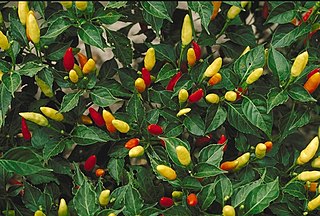 W
WCapsicum frutescens is a wild chili pepper having genetic proximity to the cultivated pepper Capsicum chinense native to the Amazon Basin. Pepper cultivars of C. frutescens can be annual or short-lived perennial plants. Flowers are white with a greenish white or greenish yellow corolla, and are either insect- or self-pollinated. The plants' berries typically grow erect; ellipsoid-conical to lanceoloid shaped. They are usually very small and pungent, growing 10–20 millimetres (0.39–0.79 in) long and 3–7 millimetres (0.12–0.28 in) in diameter. Fruit typically grows a pale yellow and matures to a bright red, but can also be other colors. C. frutescens has a smaller variety of shapes compared to other Capsicum species. C. frutescens has been bred to produce ornamental strains because of its large quantities of erect peppers growing in colorful ripening patterns.
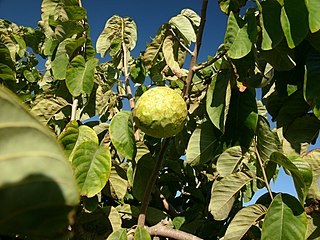 W
WThe cherimoya, also spelled chirimoya and called chirimuya by the Inca people, is a species of edible fruit-bearing plant in the genus Annona, from the family Annonaceae, which includes the closely related sweetsop and soursop. The plant has long been believed to be native to Colombia, Ecuador, Peru, Bolivia, and Chile, with cultivation practiced in the Andes and Central America, although a recent hypothesis postulates Central America as the origin instead, because many of the plant's wild relatives occur in this area.
 W
WThe chili pepper, from Nahuatl chīlli, is the berry-fruit of plants from the genus Capsicum which are members of the nightshade family, Solanaceae. Chili peppers are widely used in many cuisines as a spice to add pungent 'heat' to dishes. Capsaicin and related compounds known as capsaicinoids are the substances giving chili peppers their intensity when ingested or applied topically. Although this definition would technically include bell peppers, in common language they are often two discrete categories: bell peppers and chili peppers.
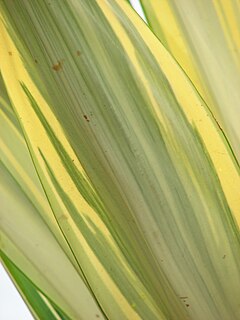 W
WFique is a natural fibre that grows in the leaves of plants in the genus Furcraea. Common names include fique, cabuya, pita, penca, penco, maguey, cabui, chuchao and coquiza.
 W
WGossypium barbadense is one of several species of cotton. It is in the mallow family. It has been cultivated since antiquity, but has been especially prized since a form with particularly long fibers was developed in the 1800s. Other names associated with this species include sea island, Egyptian, Pima, and extra-long staple (ELS) cotton.
 W
WJuglans neotropica is a species of plant in the Juglandaceae family. It is found in Colombia, Ecuador, and Peru. It is threatened by habitat loss. Common names include Colombian walnut, Ecuadorian walnut, Andean walnut, nogal, cedro negro, cedro nogal, and nogal Bogotano.
 W
WLupinus mutabilis is a species of lupin grown in the Andes, mainly for its edible bean. Vernacular names include tarwi, chocho, altramuz, Andean lupin, South American lupin, Peruvian field lupin, and pearl lupin. Its nutrient-rich seeds are high in protein, as well as a good source for cooking oil. However, their bitter taste has made L. mutabilis relatively unknown outside the Andes, though modern technology makes it easier to remove the bitter alkaloids. Like other species of lupin beans, it is expanding in use as a plant-based protein source.
 W
WThe mountain papaya also known as mountain pawpaw, papayuelo, chamburo, or simply "papaya" is a species of the genus Vasconcellea, native to the Andes of northwestern South America from Colombia south to central Chile, typically growing at altitudes of 1,500–3,000 metres (4,900–9,800 ft).
 W
WNicotiana glauca is a species of wild tobacco known by the common name tree tobacco. Its leaves are attached to the stalk by petioles, and its leaves and stems are neither pubescent nor sticky like Nicotiana tabacum. It resembles Cestrum parqui but differs in the form of leaves and fusion of the outer floral parts. It grows to heights of more than two meters.
 W
WOxalis tuberosa is a perennial herbaceous plant that overwinters as underground stem tubers. These tubers are known as uqa in Quechua, oca in Spanish, yam in New Zealand and a number of other alternative names. The plant was brought into cultivation in the central and southern Andes for its tubers, which are used as a root vegetable. The plant is not known in the wild, but populations of wild Oxalis species that bear smaller tubers are known from four areas of the central Andean region. Oca was introduced to Europe in 1830 as a competitor to the potato, and to New Zealand as early as 1860.
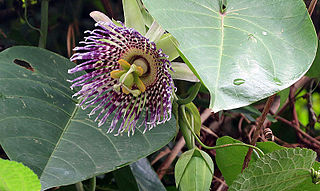 W
WPassiflora ligularis, commonly known as the sweet granadilla or grenadia, is a plant species in the genus Passiflora. It is known as granadilla in Bolivia, Colombia, Nicaragua, Costa Rica, Ecuador, Mexico, the Azores Islands, South Africa and Peru; granadilla común in Guatemala; granadilla de China or parcha dulce in Venezuela and granaditta in Jamaica.
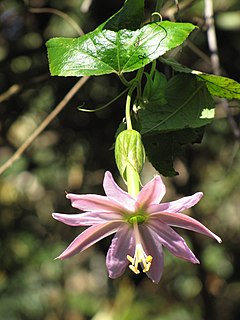 W
WPassiflora tarminiana is a species of passionfruit. The yellow fruits are edible and their resemblance to small, straight bananas has given it the name banana passionfruit in some countries. It is native to the uplands of tropical South America and is now cultivated in many countries. In Hawaii and New Zealand it is now considered an invasive species. It was given the name banana passionfruit in New Zealand, where passionfruit are also prevalent. In Hawaii, it is called banana poka. In its Latin American homeland, it is known as curuba, curuba de Castilla, or curuba sabanera blanca (Colombia); taxo, tacso, tagso, tauso (Ecuador); parcha, taxo (Venezuela), tumbo or curuba (Bolivia); tacso, tumbo, tumbo del norte, trompos, tintin or purpur (Peru).
 W
WPouteria caimito, the abiu, is a tropical fruit tree originated in the Amazonian region of South America. It grows to an average of 33 feet (10 m) high, and can grow as high as 116 feet (35 m) under good conditions. Its fruits' shape varies from round to oval, pointed at the distal end. When ripe, it has smooth, bright yellow skin and has one to four ovate seeds. The inside of the fruit is translucent and white. It has a creamy and jelly-like texture and its taste is similar to the sapodilla — a sweet caramel custard. The abiu tree is part of the family Sapotaceae and is very similar in appearance to the canistel.
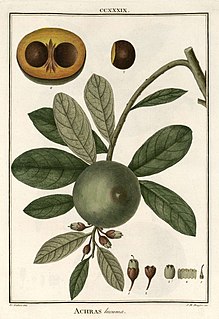 W
WPouteria lucuma is a species of tree in the family Sapotaceae, cultivated for its fruit, the lúcuma. It is native to the Andean valleys of Bolivia, Chile, Ecuador, and Peru.
 W
WQuararibea cordata, the South American sapote or chupa-chupa, is a large, semi-deciduous, fruit tree, native to Amazon rainforest vegetation in Brazil, Colombia, Ecuador, and Peru. It bears orange-yellow fruit which are soft, juicy, sweet and contain 2-5 seeds. Fruit is usually eaten out of hand, though it may be juiced.
 W
WQuinoa is a flowering plant in the amaranth family. It is a herbaceous annual plant grown as a crop primarily for its edible seeds; the seeds are rich in protein, dietary fiber, B vitamins, and dietary minerals in amounts greater than in many grains. Quinoa is not a grass, but rather a pseudocereal botanically related to spinach and amaranth, and originated in the Andean region of northwestern South America. It was first used to feed livestock 5,200–7,000 years ago, and for human consumption 3,000–4,000 years ago in the Lake Titicaca basin of Peru and Bolivia.
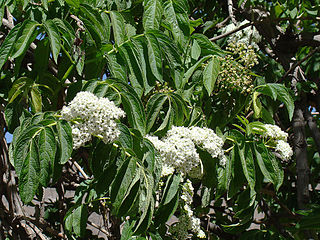 W
WSambucus peruviana is a species of tree in the family Adoxaceae. It is native to Central America and South America.
 W
WGossypium barbadense is one of several species of cotton. It is in the mallow family. It has been cultivated since antiquity, but has been especially prized since a form with particularly long fibers was developed in the 1800s. Other names associated with this species include sea island, Egyptian, Pima, and extra-long staple (ELS) cotton.
 W
WSolanum caripense is a species of evergreen shrub native to South America and grown for its edible fruit.
 W
WSolanum muricatum is a species of evergreen shrub native to South America and grown for its sweet edible fruit.
 W
WSolanum pachyandrum, known as bombona, is a spine-forming vine of the Solanum genus. It is native to southwestern Ecuador and northwestern Peru where the large juicy fruit is commonly eaten and considered a treat by children. Although the plant has been known and consumed by the indigenous people of that land, it was only published scientifically in 1914 by German botanist Friedrich August Georg Bitter.
 W
WSolanum pimpinellifolium, commonly known as the currant tomato or pimp, is a wild species of tomato native to Ecuador and Peru but naturalized elsewhere, such as the Galápagos Islands. Its small fruits are edible, and it is commonly grown in gardens as an heirloom tomato, although it is considered to be wild rather than domesticated as is the commonly cultivated tomato species Solanum lycopersicum. Its genome was sequenced in 2012.
 W
WSolanum pseudocapsicum is a nightshade species with mildly poisonous fruit. It is commonly known as the Jerusalem cherry, Madeira winter cherry, or, ambiguously, "winter cherry". These perennials can be grown decoratively as house plants, but in some areas of South Africa, India, Australia and New Zealand it is regarded as a weed.
 W
WSolanum pseudolulo is a subtropical perennial plant from northwestern South America. The pseudolulo is a large herbaceous plant or a small shrub, with heart-shaped leaves. The leaves and stems of the plant are covered in short hairs, and the entire plant is often covered in sharp spines.
 W
WSolanum quitoense, known as Naranjilla in Ecuador, Costa Rica, and Panama and as Lulo in Colombia, is a tropical perennial plant from northwestern Colombia. The specific name for this species of nightshade means "from Quito."
 W
WThe tamarillo is a small tree or shrub in the flowering plant family Solanaceae. It is best known as the species that bears the tamarillo, an egg-shaped edible fruit. It is also known as the tree tomato, tomate de árbol, tomate andino, tomate serrano, blood fruit, tomate de yuca, tomate de españa, sachatomate, berenjena and tamamoro in South America, and terong Belanda in Indonesia. It is popular globally, especially in Peru, Colombia, New Zealand, Ecuador, Rwanda, Australia, and the United States.
 W
WTropaeolum tuberosum is a species of flowering plant in the family Tropaeolaceae, grown in the Andes, particularly in Peru and Bolivia, and to a lesser extent in Ecuador as well as in some areas of Colombia, for its edible tubers, which are eaten cooked or roasted as a vegetable. It is a minor food source, especially to native Amerindian populations. Mashua is a herbaceous perennial climber growing to 2–4 m (7–13 ft) in height. It is related to garden nasturtiums, and is occasionally cultivated as an ornamental for its brightly coloured tubular flowers.
 W
WUllucus is a genus of flowering plants in the family Basellaceae, with one species, Ullucus tuberosus, a plant grown primarily as a root vegetable, secondarily as a leaf vegetable. The name ulluco is derived from the Quechua word ulluku, but depending on the region, it has many different names. These include illaco, melloco, chungua or ruba, olluco or papa lisa, or ulluma.